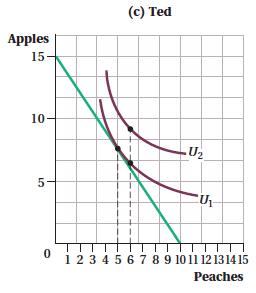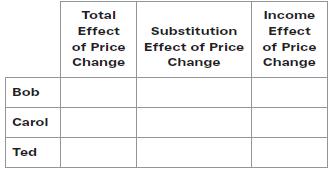12. Consider the following three graphs, which illustrate the preferences of three consumers (Bob, Carol, and Ted)
Question:
12. Consider the following three graphs, which illustrate the preferences of three consumers (Bob, Carol, and Ted) regarding two goods, apples and peaches. Each consumer has an income of
$30, and each consumer pays $2 for apples and
$3 for peaches.


a. Suppose that the price of peaches falls to $2. Draw a new budget line for each consumer and find the new optimal bundle of apples and peaches each would buy. How does the new quantity of peaches compare to the original quantity? Indicate the change in the first column of the table below (an increase of one unit might be denoted as a +1).
b. For each consumer, determine the substitution effect of the price change by drawing a hypothetical budget line with the same slope as your new budget line, but just tangent to the consumer’s original indifference curve.
How much of a change in peach consumption does the substitution effect account for? Indicate that change in the first column of the table below.
c. Now add in the income effect. Compare each consumer’s peach consumption in (b)
to his or her final peach consumption in (a).
Indicate the difference in column 3 of the table below. Double-check your work to ensure that the last two columns add up to the number in the first column.
d. Do Bob, Carol, and Ted consider peaches normal, inferior, or income-inelastic?

Step by Step Answer:

Microeconomics
ISBN: 9780716759751
1st Edition
Authors: Austan Goolsbee, Steven Levitt, Chad Syverson






